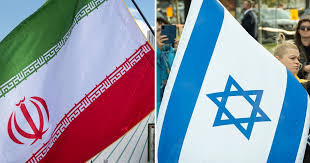The Israel-Iran confrontation could serve as a template for future wars: decentralized, digitized, deniable, but deeply destabilizing.
As the Iran-Israel conflict escalates, the Middle East finds itself amid a war unlike anything it has seen before. What began with Israel’s pre-emptive strike on June 13 targeting Iran’s nuclear sites at Natanz, Isfahan, and Fordow along with high-profile assassinations of Iranian nuclear scientists and IRGC commanders, has quickly escalated into a confrontation stretching far beyond Tel Aviv and Tehran. Iran’s retaliation has included drone and missile attacks on Israeli cities, threats to maritime traffic in the Strait of Hormuz, and strikes on US assets in the Gulf. Meanwhile, the Trump administration has claimed aerial superiority and may be preparing for deeper involvement. This is not a war confined to borders or shaped by traditional objectives; it is unfolding across domains, with implications for global security, energy stability, and geopolitical alignments.
To understand the nature of this conflict, it is essential to step back and compare it with the conventional Arab-Israeli wars of the twentieth century. Between 1948 and 1973, Israel fought four major wars against Arab coalitions, conflicts that were straightforward in structure, fought by regular armies with visible frontlines and clear territorial aims. The wars were brutal but linear. Following the 1978 Camp David Accords with Egypt and the 1994 treaty with Jordan, the region entered a new phase marked by the rise of non-state actors such as Hezbollah and Hamas. This era introduced hybrid warfare, in which Israel found itself countering ideologically driven militias operating from the shadows with state-sponsored backing, especially from Iran.
Yet the current Iran-Israel confrontation departs from even the hybrid model. What we are witnessing is a direct confrontation between two state actors—both technologically advanced, ideologically rigid, and militarily prepared—who are simultaneously leveraging proxies, cyber tools, AI-enhanced targeting systems, disinformation campaigns, and conventional military force. Iran deploys its “ring of fire” strategy through non-state allies, while launching hypersonic missiles, drone swarms, and precision-guided munitions. Israel, in turn, pursues strategic depth through pre-emptive aerial strikes, high-value assassinations, and cyber sabotage of nuclear infrastructure.
This is not merely hybrid warfare. It is more accurately described as Integrated Multi-Domain State Conflict (IMDSC)—a new paradigm wherein kinetic and non-kinetic tactics are simultaneously employed across land, sea, air, cyber, space, and cognitive domains. IMDSC moves beyond the boundaries of classical war and blurs the lines between conflict and deterrence, peace and escalation. It is a war of tempo and velocity, shaped by strategic ambiguity where decision cycles shrink and frontlines become virtual.
The stakes for Israel are existential. With Iran enriching uranium to 60% and possessing the technological know-how to cross the weapons-grade threshold, Israeli leadership fears a shift from conventional deterrence to what it terms “nuclear terrorism.” This scenario entails Tehran enabling its proxies to deploy nuclear or radiological threats against Israeli territory, an unacceptable red line. Acting under its “Never Again” doctrine, Israel has initiated what it sees as a pre-emptive campaign not just against physical assets, but against a strategic future it cannot allow to materialize.
Iran, for its part, frames this as a war of sovereignty and deterrence. With economic hardship, internal unrest, and mounting pressure from Western allies of Israel, the regime views its ability to project power through asymmetric means as vital to its survival and regional influence.
However, in such technologically sophisticated and ideologically entrenched conflicts, there is an inherent paradox. The very features that give each actor expanded reach—precision strikes, non-attribution tactics, and cyber warfare—also compress the space for diplomatic resolution. The absence of defined frontlines or conventional escalation ladders means that each move risks spiralling into a strategic miscalculation. This kind of warfare is not designed for decisive victory; it is designed for positioning and attrition. And therein lies the enduring risk.
It is in this context that diplomacy, often sidelined in moments of crisis, emerges not as an idealistic fallback but as a strategic necessity. In wars where both actors possess formidable retaliatory capacity and where the costs of escalation could spill across regions and global markets, diplomacy becomes the only viable exit ramp. IMDSC creates warfare without borders, but also creates dead-ends, that is, scenarios where neither side can win outright nor afford to lose. The war becomes self-sustaining.
In such a scenario, the role of third-party mediators, strategic backchannels, and crisis-management protocols become more relevant than ever. The United States, already deeply involved, may seek to use its leverage not only to protect allies but to prevent the collapse of deterrence structures in the Gulf. Similarly, middle powers like India, France, the UAE, and Oman, who maintain working relations with both Iran and Israel, may find space to promote de-escalation frameworks.
Even diplomacy, however, must evolve to meet the demands of contemporary conflict. Traditional summitry or arms control models may be inadequate in managing wars that unfold across cyberspace, operate through proxy networks, and rely on narrative dominance. Confidence-building in this new era must address not only state-to-state guarantees, but the activities of non-state actors, cyber norms, disinformation monitoring, and mechanisms for rapid communication even in the absence of formal diplomatic ties.
At the global level, the conflict has already produced ripple effects. Oil prices are volatile, shipping routes remain vulnerable, and foreign missions across the region are operating under elevated threat levels. The risk of spillover into Iraq, Syria, Lebanon, or even the Red Sea corridor is real. For the broader international community, the Israel-Iran confrontation could serve as a template for future wars: decentralized, digitized, deniable, but deeply destabilizing.
This is not 1973. There are no massed tank columns in the Sinai or dogfights over the Golan Heights. This is a war with no defined fronts and no declared endings, fought in the shadows of data centres, oil corridors, satellite constellations, and encrypted apps. Israel and Iran are not merely fighting each other; they are pioneering a new form of 21st century warfare. As other nations observe and adapt, one thing is becoming clear. The future of conflict will not be determined by battlefield victories alone, but by how states manage escalation, control information, and keep diplomacy within reach.
* Author is a subject matter expert at Centre for Joint Warfare Studies and is the author of “India and the Gulf: A Security Perspective”.







